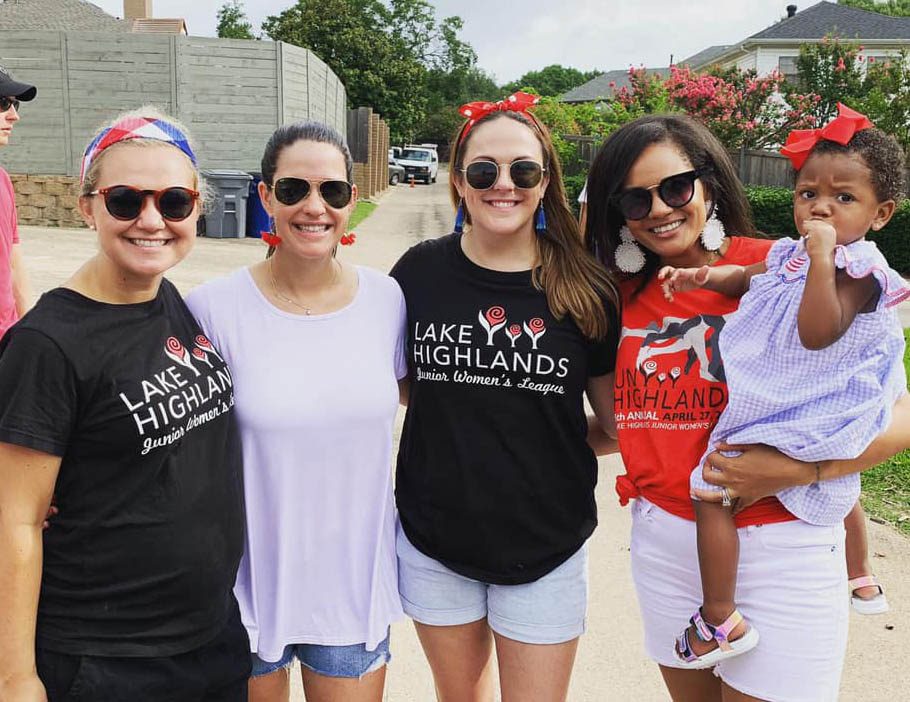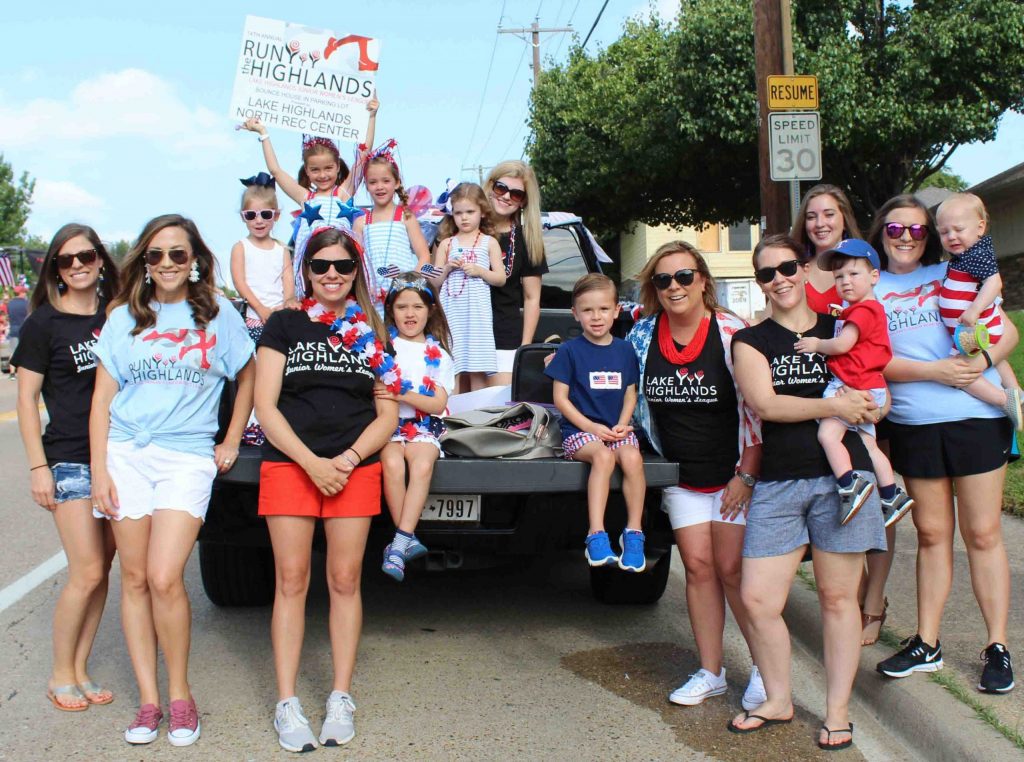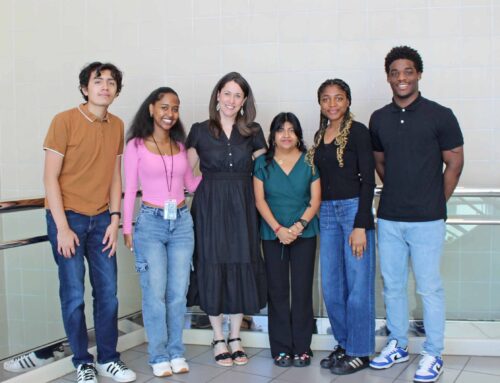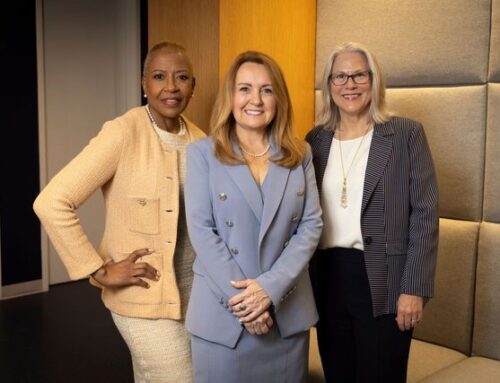
Mallory Mullen, Caitlin Dotson, Kati Ann Long and Bronwyn Jefferson represent LHJWL in the Exchange Club’s July 4 parade last year
Think you know the Lake Highlands Junior Women’s League? Leaders of the organization say they’re fighting a problem of perception. With more than 120 active members and a long list of completed projects in the community, they are hardly just “ladies who lunch.”
Founded in 2004 by six Lake Highlands High School graduates whose mothers had been active members of Lake Highlands Women’s League, the group includes movers-and-shakers in charitable, political and educational organizations all over Dallas, and 74% of its members now work full or part time.
“We are small business owners, attorneys, teachers, a chief of staff for a judge, blogger/influencers, nurses and dentists,” says Membership Chair Ali Cullum. “We’ve got some seriously hardworking ladies who are devoting extra time they don’t have.”
There’s no “recommendation” or “sponsor” required to join – interested women simply register online. The league has always drawn a waitlist, but this year’s applicants are likely to become next year’s new members. Meetings are held on Monday evenings to accommodate busy schedules, and flexibility is built in for the inevitable glitches of hectic families.
Women of color comprise only a handful of LHJWL’s active membership, and some African American and Hispanic members who have left the group said the civic organization “just wasn’t for them.” Cullum and incoming president Bronwyn Jefferson hope dispelling misperceptions about the league will help boost minority membership and attract a more diverse group of volunteers.
“Coming into this year and knowing I’m the first person of color to lead this organization, [recruiting more widely] is something I thought about even before this racial and social unrest started going on,” explains Jefferson, who lives in LH with her husband, Jared, a 2006 graduate of LHHS. “It’s hard because women in the league don’t currently come from all the elementary schools across Lake Highlands. We don’t have anyone, or maybe just one, from schools like Aiken, Stults and Skyview. So it’s been a challenge.”
Large numbers of LHJWL members live in White Rock, Moss Haven and Lake Highlands Elementary neighborhoods, which are mostly white. Some members also live in Wallace and Northlake areas, which tend to be more racially diverse.
“Currently, people learn about the league by word-of-mouth,” explains Cullum. “At meetings we tell our ladies to invite two friends to join our wait list, so if you have a group of WRE or MHE or LHE moms who turn to their left and right to invite their neighbors, it accidentally creates a systemic situation. What we’re really striving for is to spread the word – not just on how to join, but also about what we do. We’re not a ladies-who-lunch club, and we’re not a garden club – our mission of ‘beautification’ is a confusing term, and it’s a lot more weighty than people understand. We want to branch out and show a bigger majority of Lake Highlands what we do and who we are, so we can become more diverse. We want our league to look like our neighborhood.”
LHJWL members have raised more than $850,000 to date, and they completed, or had a role in completing, the Flag Pole Hill Playground, the Lake Highlands North Splash Park, the Audelia Library Children’s Area, the Wildcat Fun Zone at the LH North Recreation Center, boulevard banners to publicize community events, large granite sculptures and other improvements in and around the LH North Recreation Center. They are currently working with Imagine Dallas to provide meals for families sheltering at home during the pandemic and working to beautify the trestle area near LHHS. They host an annual school supply drive and an Angel Tree to provide clothing and gifts to children at Christmas. They host events, like Light Up the Highlands and Run the Highlands, which bring the community together and create lasting memories for families which participate.
Jefferson knows that her high-profile role in the league may help her connect with women who would not have previously listened to a recruiting pitch. She plans to go into LH area feeder schools to invite members of their PTA, booster clubs and other groups – especially at majority-minority elementaries.
“I’m probably not going to feel like joining LHJWL if I’m doing a shift at Oktoberfest and nobody looks like me,” Jefferson says, explaining why her peers of color might be hesitant to sign up. “I’m probably going to feel uncomfortable.”
Jefferson and Cullum are also strategizing to make sure new recruits choose to remain in the league. During her first year as a member, Cullum says she often felt like an outsider. Other women seemed to enjoy already-formed friendships, and she wasn’t certain she fit in. Those early feelings, she says, helped her imagine how a woman of color might feel and helped the group craft strategies to welcome new members.
“We seat people by neighborhoods at general meetings, so that everyone at your table is someone you might see on your street. We created Neighborhood Captains, who put together cocktail hours or stroller walks or other social hours to help people feel more comfortable at large scale events. As leadership, it’s our job to make sure nobody walks in the door without at least five people learning their name and saying hello.”
Jefferson says she’ll use her role as president to push veteran members to welcome new ones.
“I encourage people to step out of their comfort zone and speak to someone they don’t know. From the top down, we want to make sure we’re helping people feel connected, and the executive board is passionate about seeing this change made. But you also get out of it what you put into it, so we want to make sure that everyone has a meaningful role so they feel a part of this organization, stay in the league longer and build our sustainers’ program.”
Once members reach the age of 40 or their youngest child enters first grade, their time in the Junior Women’s League is over and they’re encouraged to devote their energies to LHWL, their children’s schools or other civic organizations. For now, Cullum says, their youthful perspective makes them ready to be change leaders.
“People our age are so ready. We’re of a different mindset. We want everybody here, and that’s a perception change.”






